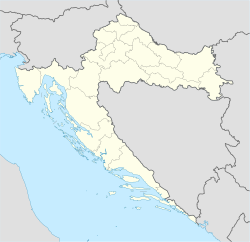world.wikisort.org - Croatia
Čavoglave is a village in Dalmatian Hinterland, Croatia with a population of 190.[2] It is part of the Ružić municipality of the Šibenik-Knin County, in the region of Dalmatia. It is located between the mountains Svilaja and Moseća, next to the source of the Čikola river. The southern edge of the village passes the D56 highway
Čavoglave | |
|---|---|
Village | |
 Church of Croatian Martyrs | |
 Čavoglave | |
| Coordinates: 43°47′01″N 16°20′14″E | |
| Country | |
| County | Šibenik-Knin County |
| Municipality | Ružić |
| Elevation | 420 m (1,380 ft) |
| Population (2020)[1] | |
| • Total | 190 |
| Time zone | UTC+1 (CET) |
| • Summer (DST) | UTC+2 (CEST) |
Although the village is not usually a tourist destination, The village has started to gain popularity due to the famous Croatian rock-ethno song "Bojna Čavoglave".[3]
Population
According to the data on the official website of the municipality, Čavoglave has 190 inhabitants.[2]
History
During the Croatian War of Independence in 1991, Čavoglave was on the very front line, but they were never occupied. A large number of locals took part in the fight against Krajina Serbs. Čavoglave was popularized by Thompson's song "Bojna Čavoglave". Čavoglave is also the birthplace of Marko Perković, the band's leader, songwriter and vocalist. He built the Church of Croatian Martyrs there at his own expense, dedicated to Croatian Army soldiers and civilians who died during the war. There is an annual fund raising concert in honor of Victory and Homeland Thanksgiving Day in Čavoglave.
Celebrities
- Marko Perković (born 1966), Croatian musician.
- Ante Dabro (born 1938), Australian painter originally from Čavoglave.
References
- Čavoglave, pristupljeno 14. studenoga 2020.
- Čavoglave, pristupljeno 14. studenoga 2020.
- "Thompson opet blizu "magične" brojke od 100 tisuća posjetitelja". Slobodna Dalmacija (in Croatian). 5 August 2011. Retrieved 13 May 2012.
External links
На других языках
[de] Čavoglave
Čavoglave ist ein Dorf in Kroatien. Es befindet sich in der Gespanschaft Šibenik-Knin an der Straße Split–Drniš, etwa 50 km von Split entfernt. Administrativ gehört es zur Gespanschaft Šibenik-Knin.- [en] Čavoglave
[ru] Чавоглаве
Чавоглаве (хорв. Čavoglave) — село в Хорватии, входит в общину Ружич (хорв. Ružić), Шибенско-Книнской жупании. Село расположено в урочище Петрово поле (хорв. Petrovo polje), на берегу реки Чиколы (хорв. Čikola), между горными хребтами Свилая и Мосеч. Исторически принадлежит к Далматинской Загоре. Высота над уровнем моря 420 м. В 1992 году село стало известно всей Хорватии.Другой контент может иметь иную лицензию. Перед использованием материалов сайта WikiSort.org внимательно изучите правила лицензирования конкретных элементов наполнения сайта.
WikiSort.org - проект по пересортировке и дополнению контента Википедии